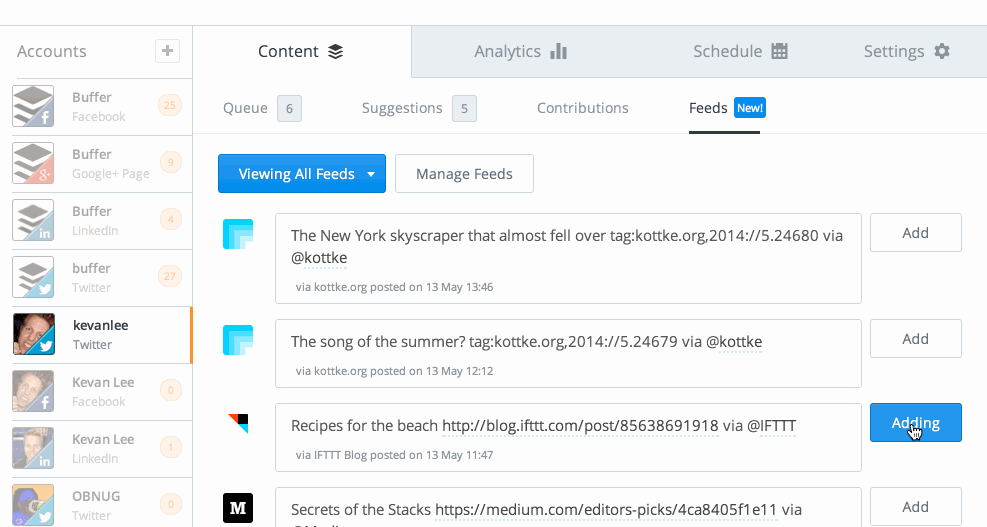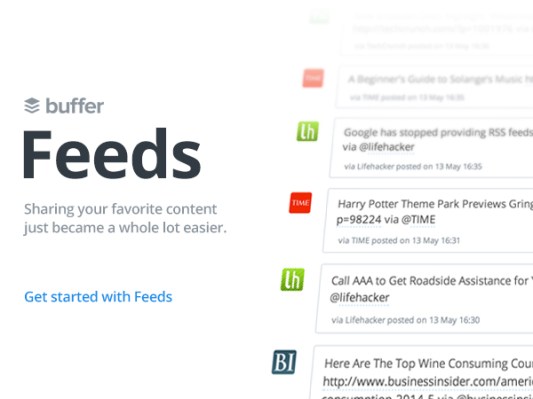Buffer, the social media scheduling app with 1.5 million users, picked up a bit of notoriety when it got hacked and its users started sending out weight-loss spam to followers, but also kudos for its generally transparent approach to business. Today, it is announcing a pivot of sorts. The company is adding two new features — a feed-reading service and curated content suggestions — as it shifts to monitoring social media content alongside its existing ability to share and analyse the impact of the content you create yourself.
Content feeds, to begin with, will be part of Buffer’s paid products, with one tier at $10/month for one feed, and $50/month for up to 10 feeds. Content suggestions, meanwhile, will be part of its free product.
Together, the two sides of Buffer’s business, pushing out and pulling in content, comprise the company’s biggest play yet at positioning itself as a social media dashboard, putting itself up against the likes of HootSuite in catering to social media power users.
Indeed, there is no intention of sunsetting its existing services as these new features get added. “We’ll also definitely keep all sharing functionality,” Leonhard Widrich, co-founder and COO of Buffer, tells me. “I’d say this is full-on extension and very much builds on top of Buffer’s sharing capabilities.”
Buffer Feeds operates like a kind of RSS service for the social media generation. You pull in feeds from blogs, news sites, and social media accounts, and then you can share those stories from your own social accounts. Widrich says that this was one of the most requested features from Buffer users, but it’s addition also comes from the company trying to solve a challenge it was finding among many users — that of engagement with the app.
“We have an issue that we call the ‘blank page’ problem at Buffer,” he told me. “A user signs up, connects their social accounts and then doesn’t know what to do next. By providing them with great content up front, it’s a much better experience. I think this also shows how well content and social play together.”
Content Suggestions, meanwhile, is an even stronger extension of leading horses to water. Here, instead of giving users carte blanche in figuring out what feeds to include on their dashboard, Buffer will make its own suggestions for users, which they can in turn share out on their own feeds.
What’s interesting is that for now Buffer has opted not to use any algorithms to suggest content.
“With a lot of algorithms out there that help you discover content, we’ve so far found that picking the stories out by hand can oftentimes still provide a better experience for users,” the company notes. “We’re excited to experiment with more topic based suggestions in the future and see how we might be able to scale hand picking stories to keep our focus on quality high.”
The company says that in a beta run of the feature, some 200,000 suggested stories have already been shared, a sign of “strong adoption”. But it also speaks to another challenge — and opportunity.
The challenge here is one that companies like Twitter have also found — when people register for the service, they often are at a loss over who to follow, what to do next. This has led Twitter down the road of creating different ways of suggesting accounts to follow, both when you sign up for the service, and also once you are there in the form of suggestions via email and account suggestions in the margins of your timeline.
The opportunity is that it gives Buffer, like Twitter, the ability, down the line, to sell this as a marketing service to different companies, where “promoted” content can then sit alongside content that is simply selected by Buffer’s algorithms. In that regard, it makes sense that Content Suggestions is coming in as part of Buffer’s free service.
All in all, this seems like a pretty logical and smart move from Buffer, but also begs the question of how they will differentiate from much bigger rivals, like HootSuite, which also offer a similar range of services in a dashboard-style format.
“I think Buffer tackles the problem of aggregating feeds from a very different perspective than other tools, with the core focus being on sharing, instead of reading, which is what nearly every other feed aggregation service focuses on,” says Widrich. “You can, with the click of a few buttons, queue up your favorite stories from your favorite sites, without worrying about over-sharing and still creating a consistent social media presence for your brand or individual feed.” Or so the hope is, at least.
Here’s an animated demo of how the feed sharing works:

There will be more differentiation to come, he promises.
“We’ve also started to work on a mobile application that leverages this super easy way of sharing items from a feed or content suggestions on mobile,” he says, describing it as a “Tinder for content sharing,” in that you swipe right on content you like and it gets queued up in your Buffer and left if you don’t want to share it.
This will be in the next iteration of Buffer’s product, he says.
To date, Buffer, which was first incubated in AngelPad, has raised some $400,000.
